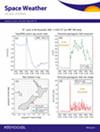Assessing the Effects of a Minor CIR‐HSS Geomagnetic Storm on the Brazilian Low‐Latitude Ionosphere: Ground and Space‐Based Observations
IF 3.7
2区 地球科学
引用次数: 0
Abstract
This paper investigates the effects of a minor G1 Co‐rotating Interaction Region (CIR)/High‐Speed Stream (HSS)‐driven geomagnetic storm that occurred on (13–14 October 2018), during deep solar minimum. We used simultaneous observations from multiple instruments, namely; ground‐based Global Navigation Satellite Systems (GNSS) receivers, a Digisonde, ground magnetometers, and space‐based observations from the National Aeronautics and Space Administration Global‐scale Observations of Limb and Disk (GOLD) and SWARM missions. This study presents a detailed picture of the low‐latitude ionosphere response over the Brazilian sector during a minor storm. Our results showed that the minor CIR/HSS‐driven storm caused a positive ionospheric storm of over ∼20 TECU in magnitude. For the first time, periodic post‐sunset irregularities and Equatorial Plasma Bubbles, equatorial plasma bubbles, were analyzed using GOLD FUV OI 135.6 nm emission, Total Electron Content (TEC) maps, Rate of TEC index, ROTI, and TEC gradients. Fluctuations in the interplanetary magnetic field Bz and changes in the thermospheric column density ratio (∑O/N2) are discussed as the main sources of ionospheric changes during the storm. This paper highlights the importance of monitoring and understanding the impact of Sun‐Earth interactions and provides insight into the behavior of the low‐latitude ionosphere during minor geomagnetic storms.小型CIR - HSS地磁风暴对巴西低纬度电离层的影响评估:地面和空间观测
本文研究了发生在2018年10月13日至14日的一次小型G1共旋转相互作用区(CIR)/高速流(HSS)驱动的地磁风暴对太阳深度极小期的影响。我们使用多个仪器同时观测,即;地面全球导航卫星系统(GNSS)接收机、地面地面仪、地面磁力计,以及来自美国国家航空航天局全球尺度翼盘观测(GOLD)和SWARM任务的天基观测。本研究详细描述了巴西地区低纬度电离层在小型风暴期间的响应情况。我们的研究结果表明,较小的CIR/HSS驱动的风暴引起了一个大于~ 20 TECU量级的电离层正风暴。首次使用GOLD FUV OI 135.6 nm发射、总电子含量(TEC)图、TEC指数率、ROTI和TEC梯度分析了周期性日落后不规则性和赤道等离子体气泡。讨论了行星际磁场Bz的波动和热层柱密度比(∑O/N2)的变化是风暴期间电离层变化的主要来源。本文强调了监测和理解太阳-地球相互作用影响的重要性,并提供了对小型地磁风暴期间低纬度电离层行为的见解。
本文章由计算机程序翻译,如有差异,请以英文原文为准。
求助全文
约1分钟内获得全文
求助全文

 求助内容:
求助内容: 应助结果提醒方式:
应助结果提醒方式:


